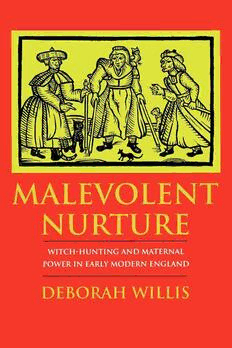
Malevolent Nurture: Witch-Hunting and Maternal Power in Early Modern England PDF
Preview Malevolent Nurture: Witch-Hunting and Maternal Power in Early Modern England
Malevolent Nurture This page intentionally left blank MALEVOLENT NURTURE WITCH-HUNTING AND MATERNAL POWER IN EARLY MODERN ENGLAND DEBORAH WILLIS CORNELL UNIVERSITY PRESS ITHACA AND LONDON Copyright © 1995 by Cornell University All rights reserved. Except for brief quotations in a review, this book, or parts thereof, must not be reproduced in any form without permission in writing from the publisher. For information, address Cornell University Press, Sage House, 511 East State Street, Ithaca, New York 14850. First published 1995 by Cornell University Press. Printed in the United States of America © The paper in this book meets the minimum requirements of the American National Standard for Information Sciences-Permanence of Paper for Printed Library Materials, ANSI 739.48-1984. Library of Congress Cataloging-in-Publication Data Willis, Deborah, 1952.- Malevolent nurture : witch-hunting and maternal power in early modern England / Deborah Willis. p. cm. Includes bibliographical references and index. ISBN 0-8014-3004-6 (cloth : alk. paper).—ISBN 0-8014-8194-5 (paper : alk. paper) i. Witchcraft—England—History. 2.. Witches—England—History. 3. Mothers—England—Social conditions. 4. Persecution—England— History. 5. Shakespeare, William, 1564-1616—Knowledge—Occultism. 6. Witchcraft in literature. I. Title. BFi58i.W55 1995 133.4*3 '0941—dczo 95-16429 CONTENTS List of Illustrations vii Preface ix ONE Introduction 1 TWO (Un)Neighborly Nurture 27 THREE Rewriting the Witch 83 FOUR James among the Witch-Hunters 117 FIVE Performing Persecution 159 SIX Strange Brew 209 Afterword. Notorious Defamations 239 Works Cited 247 Index 261 This page intentionally left blank LIST OF ILLUSTRATIONS 1. Title page from A Detection of damnable driftes (1579) 31 2. Witch sending familiar into action against her neighbor, from A Rehearsal! both straung and true (i579) 53 3. Witch feeding familiars, from A Rehearsall both straung and true (1579) 53 4. Title page from The Apprehension and confession of three notorious Witches (1589) 54 5. Witches with familiars, from The Wonderful Discoverie of the Witchcrafts of Margaret and Phillip Flower (1619) 57 6. Title page, from George Gifford, A Dialogue concerning Witches and Witchcraftes (1593) 96 7. Title page from George Gifford, A Discourse of the subtill Practises ofDevilles by Witches and Sorcerers (1587) 107 8. Scenes from Newes from Scotland (1591) 127 viii LIST OF ILLUSTRATIONS 9. Mary Queen of Scots and her son James, from John Leslie, bishop of Ross, Ad Nobilitatem Populumq, Scoticum (1578) 134 10. The devil instructs his followers, from Francesco Guazzo, Compendium Maleficarum (1608) 149 11. Witches pay-homage to the devil by kissing his buttocks, from Francesco Guazzo, Compendium Maleficarum (1608) 150 12. Witches and devils dance to music, from Francesco Guazzo, Compendium Maleficarum (1608) 151 PREFACE When I first began work on a book about witch-hunting and gender in early modern England, I did not know that it was also going to be about mothers. But as I began to look more closely at relevant documents, it be- came evident that the crime of witchcraft was often described in terms of the maternal. Witches were—or were believed to be—mothers "gone bad," women past childbearing years who used their mothering powers against neighbors who had enraged them. To acquire their magic, women fed and cared for demonic imps as if they were children. In exchange, imps would bring sickness and death to other households—often the households of younger mothers. Although most features of these beliefs have been known to scholars for some time, few have explored the implications of the witch as mother. That is in essence what I do here, in the hope of contributing to a better understanding of cultural practices that sent many innocent people to their deaths. I have concentrated on the period 1563-1611, examining a variety of nonliterary texts—state papers, trial records, pamphlets, reli- gious tracts—as well as selected plays by William Shakespeare. In En- gland, the establishment of a flourishing professional theater and the rise of secular prosecutions against the crime of witchcraft roughly coincided: statutes passed in 1563 led to a steady series of trials beginning in the 15708, and the first playhouse was built just outside London in 1574. It is during these years that basic features of witch-hunting were established and that witchcraft emerged as a distinctively female crime—a crime often punished, on stage and in trial courts, as a perverse use of maternal power.
